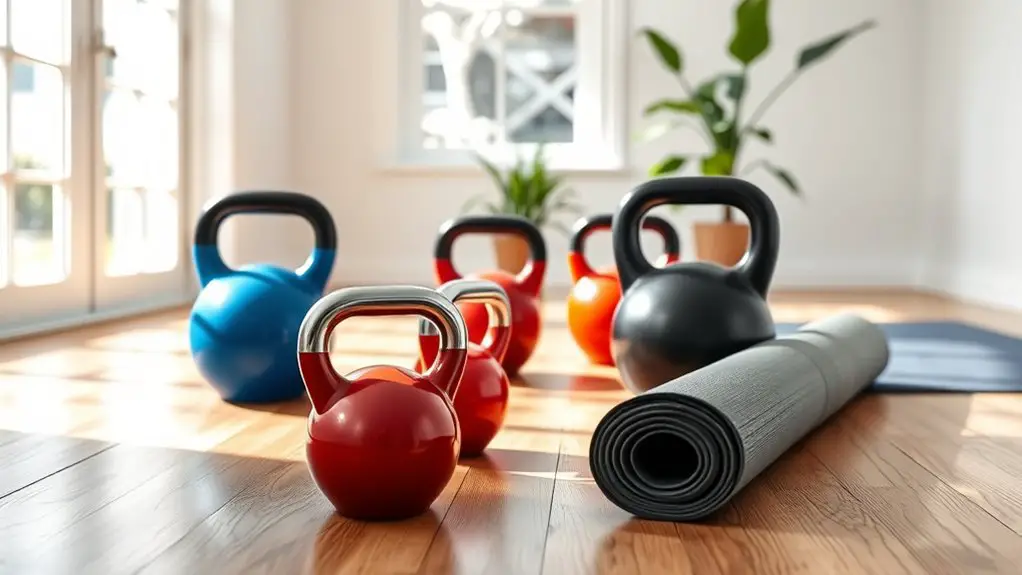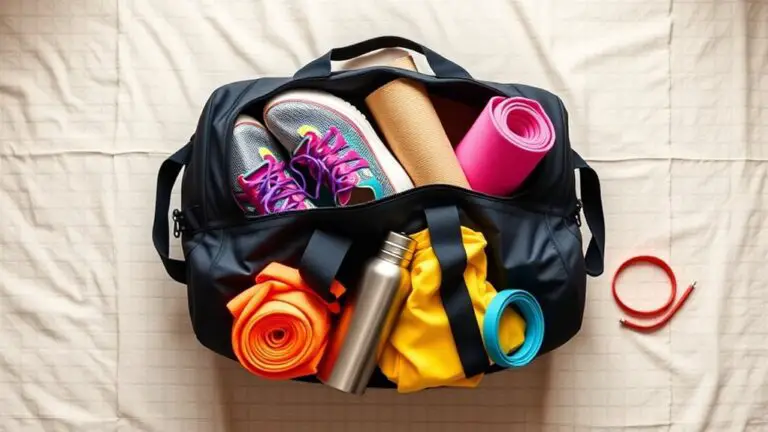Kettlebell Workouts for a Home Gym Setup

Kettlebell workouts are perfect for your home gym setup as they combine strength training, cardio, and flexibility in one compact tool. You can easily fit in essential exercises like swings, goblet squats, and Turkish get-ups into your routine. Plus, they help improve endurance and engage your core. With a balanced approach, you can mix beginners’ workouts with advanced movements to challenge yourself. There’s plenty more to explore on how to maximize your kettlebell training!
The Benefits of Kettlebell Workouts

Kettlebell workouts offer a dynamic approach to fitness that can transform your home gym experience. One of their biggest advantages is kettlebell versatility; these weights can be used for various exercises, targeting multiple muscle groups simultaneously. This means you can build strength endurance while maximizing your workout time.
When incorporating kettlebells into your routine, you’ll find that they engage your core, improve coordination, and enhance flexibility—essential elements for overall fitness. Plus, because kettlebell movements often involve dynamic, functional patterns, you’re less likely to strain yourself if you focus on proper form.
Safety is paramount, so start with lighter weights until you’re comfortable with the movements. This way, you can avoid injury while still reaping the benefits of increased strength and endurance. With consistent practice, kettlebell workouts can lead to significant improvements, making them an excellent addition to your home gym setup.
Essential Kettlebell Exercises for Beginners
If you’re new to kettlebell workouts, starting with a few essential exercises can set a solid foundation for your fitness journey. Begin with the kettlebell swing, which builds strength and endurance. Make certain to maintain proper kettlebell grips to avoid injury. Next, try the goblet squat, a great way to develop lower body strength while keeping your form in check.
Another key exercise is the kettlebell deadlift, which targets your posterior chain. Focus on your posture and avoid common beginner mistakes, like rounding your back. Finally, incorporate the Turkish get-up for a full-body workout that enhances stability and mobility.
Always warm up before diving into these exercises, and don’t rush your movements. Practicing these fundamental moves will help you gain confidence and guarantee you’re moving safely as you progress in your kettlebell journey.
Building a Balanced Kettlebell Routine

Creating a balanced kettlebell routine involves incorporating a variety of exercises that target different muscle groups and energy systems. Start with foundational movements like swings, goblet squats, and Turkish get-ups to build strength and coordination. Use kettlebell variations such as snatches and clean-and-press to challenge your body in new ways, enhancing overall fitness.
Aim for a mix of strength, endurance, and flexibility exercises. For instance, combine high-rep swings for cardio with low-rep heavy lifts for strength. As you progress, gradually increase the weight or the complexity of your kettlebell variations to guarantee your workouts remain effective and engaging.
It’s essential to listen to your body and adjust your routine as needed, prioritizing safety. Incorporating this balanced approach will not only help prevent injury but also keep you motivated on your fitness journey.
Tips for Proper Kettlebell Form
When you’re using kettlebells, proper grip and hand position are vital for both safety and effectiveness. Don’t forget to engage your core throughout each movement, as this will help stabilize your body and maximize your workout. Let’s explore these essential tips to guarantee you’re getting the most out of your kettlebell training.
Grip and Hand Position
Although mastering your grip and hand position may seem minor, it plays an essential role in guaranteeing effective and safe kettlebell workouts. Proper grip strength is imperative; a secure hold allows you to control the kettlebell, reducing the risk of injury. Always grip the handle firmly, keeping your fingers wrapped around it while using your palms for support. This promotes hand stability, which is significant during dynamic movements. When performing swings or snatches, verify your wrists remain neutral to avoid strain. Remember to adjust your grip based on the exercise; a wider grip may be necessary for certain lifts. By focusing on your grip and hand position, you’ll enhance your performance and maintain safety throughout your kettlebell routine.
Core Engagement Techniques
Core engagement is essential for maximizing the effectiveness of your kettlebell workouts. Proper core stability not only enhances performance but also reduces the risk of injury. Before you start any lift, make certain your abs are tight and your pelvis is slightly tucked. This promotes muscle activation throughout your core. During movements like swings or goblet squats, focus on keeping your torso upright and bracing your midsection as if you’re about to be punched. This helps maintain balance and control. Remember to breathe; exhale during exertion and inhale on the way down. By prioritizing core engagement, you’ll not only lift more effectively but also protect your lower back and improve overall strength. Stay safe and strong!
Advanced Kettlebell Movements to Challenge Yourself

If you’re ready to elevate your kettlebell training, challenging yourself with advanced movements can greatly enhance your strength, stability, and coordination. Start with turbo swings to boost your power output, then progress to Turkish get ups for full-body engagement. Advanced snatches can help elevate your heart rate while improving your explosive strength. Consider adding double kettlebell exercises for increased resistance, and single arm cleans to enhance stability and grip strength.
Incorporate overhead lunges to build leg strength and core stability simultaneously. Don’t forget about kettlebell complexes, which combine multiple movements into a single flow, maximizing efficiency. Finally, renegade rows will engage your back and core while promoting balance. As you tackle these advanced movements, always prioritize proper form to minimize the risk of injury. Challenge yourself, but listen to your body. Progress gradually, and you’ll reap the benefits of your hard work.
Incorporating Kettlebells Into Cardio Workouts
If you’re looking to boost your cardio routine, kettlebells can be a game changer. You can incorporate them into circuit training or high-intensity interval workouts to combine strength and cardio effectively. Let’s explore how to seamlessly integrate kettlebells for maximum impact in your fitness regimen.
Kettlebell Circuit Training
Incorporating kettlebells into your cardio workouts can elevate your fitness routine by combining strength training with high-intensity intervals. Kettlebell circuit training allows you to perform kettlebell circuit combinations that target various muscle groups while keeping your heart rate elevated. Start with basic kettlebell workout variations like swings, goblet squats, and cleans, ensuring you maintain proper form to prevent injury. As you progress, mix in different exercises to challenge yourself and prevent boredom. Aim for a balanced routine, focusing on both upper and lower body movements. Remember to warm up before starting and cool down after your workout. By prioritizing safety and gradually increasing intensity, you’ll build strength and endurance effectively and enjoyably.
High-Intensity Interval Training
While many people think of kettlebells as tools for strength training, they can also be a game-changer for high-intensity interval training (HIIT). Incorporating kettlebells into your HIIT workouts can enhance your cardio routine while adding resistance for better muscle engagement. You’ll experience HIIT benefits such as improved endurance, increased metabolism, and enhanced overall fitness.
To keep your workouts safe, focus on proper form and choose a weight that suits your fitness level. You can explore various HIIT variations, like kettlebell swings followed by burpees or goblet squats paired with high knees. By alternating between kettlebell exercises and cardio bursts, you’ll maximize your results while minimizing the risk of injury.
Combining Strength and Cardio
Kettlebells can elevate your cardio workouts by seamlessly blending strength training with cardiovascular conditioning. Incorporating kettlebell exercises can enhance your fitness while ensuring safety and effectiveness. Here are four ways to combine strength and cardio using kettlebells:
- Kettlebell Swings: These are fantastic for developing strength endurance while improving your heart rate.
- Goblet Squats: Holding the kettlebell close to your chest, you can build lower body strength while engaging your core.
- Kettlebell Deadlifts: They help in strengthening your posterior chain and boosting metabolic conditioning.
- Kettlebell Clean and Press: This full-body movement combines strength and cardio benefits, challenging your endurance.
Creating a Kettlebell Workout Schedule
To get the most out of your kettlebell workouts, creating a structured schedule is crucial. Start by determining your kettlebell frequency—aim for at least three to four sessions per week. This guarantees you’re consistently training while allowing your muscles time to recover.
Next, consider your workout duration. Sessions between 20 to 40 minutes are ideal for maximizing effectiveness without overexertion. During each workout, balance strength and cardio exercises to keep your routine engaging and thorough.
It’s also helpful to alternate between different muscle groups, focusing on upper body one day and lower body the next. This way, you’ll maintain a well-rounded fitness approach while minimizing the risk of injury.
Safety Considerations for Kettlebell Training
Having a structured kettlebell workout schedule is essential, but prioritizing safety is equally important. To guarantee injury prevention and equipment safety, keep these key considerations in mind:
- Warm-Up Properly: Always start with a dynamic warm-up to prepare your muscles and joints for kettlebell movements.
- Choose the Right Weight: Use a kettlebell weight that matches your fitness level. Starting too heavy can lead to poor form and injuries.
- Focus on Form: Maintain proper technique throughout each exercise. If you’re unsure, consider working with a trainer or watching instructional videos.
- Clear Your Space: Confirm your workout area is free from obstacles. A clutter-free environment helps prevent accidents and injuries.
Frequently Asked Questions
What Size Kettlebell Should I Start With as a Beginner?
When you’re starting out with kettlebells, it’s essential to choose the right kettlebell weight to guarantee safety. For most beginners, a weight between 8 to 12 kg (18 to 26 lbs) is a good starting point, but this can vary based on your fitness level. Remember, you want to focus on form and technique. Beginner tips include starting light, gradually increasing weight, and always warming up to prevent injury.
How Often Should I Replace My Kettlebells?
You might think of your kettlebell as a trusty companion on your fitness journey. To guarantee safety and performance, take into account its lifespan; typically, kettlebells can last several years with proper care. However, if you notice signs of wear and tear, it’s wise to think about a replacement. A good rule of thumb for replacement frequency is about every 3 to 5 years, keeping your workouts both enjoyable and safe as you progress.
Can Kettlebell Workouts Help With Weight Loss?
Absolutely, kettlebell workouts can help with weight loss! Their unique design offers a variety of kettlebell benefits, like enhancing strength and endurance. By focusing on workout intensity, you’ll torch calories and improve your metabolism. Just remember to prioritize safety—start with lighter weights to master your form before progressing. Consistency is key, so incorporate kettlebell routines into your weekly plan, and you’ll see results while enjoying a fun and dynamic workout!
Are Kettlebells Suitable for All Fitness Levels?
Did you know that over 60% of people find kettlebell workouts accessible? They’re suitable for all fitness levels, especially with kettlebell modifications. If you’re just starting out, beginner workouts can ease you into the routine safely. By adjusting weights and focusing on form, you can build strength without risking injury. So, whether you’re a novice or more experienced, kettlebells can be a great addition to your fitness journey!
How Do I Clean and Maintain My Kettlebells?
To keep your kettlebells in top shape, regularly wipe them down with a damp cloth to remove sweat and grime. Store them in a cool, dry place to prevent rust and damage. Ascertain kettlebell safety by checking for any signs of wear, like cracks or loose handles. Proper kettlebell storage, like a designated rack, can help prevent accidents and keep your workout area organized. Always prioritize safety when maintaining your equipment!





